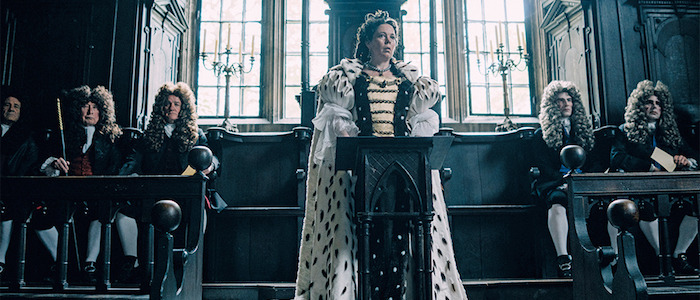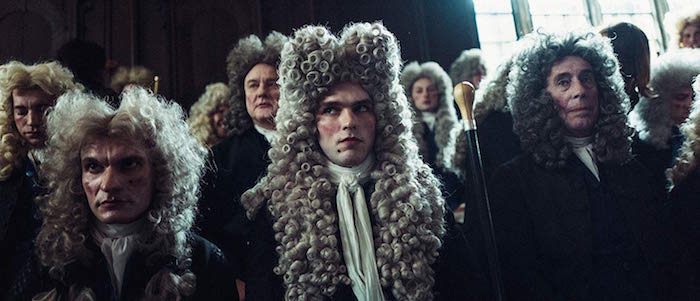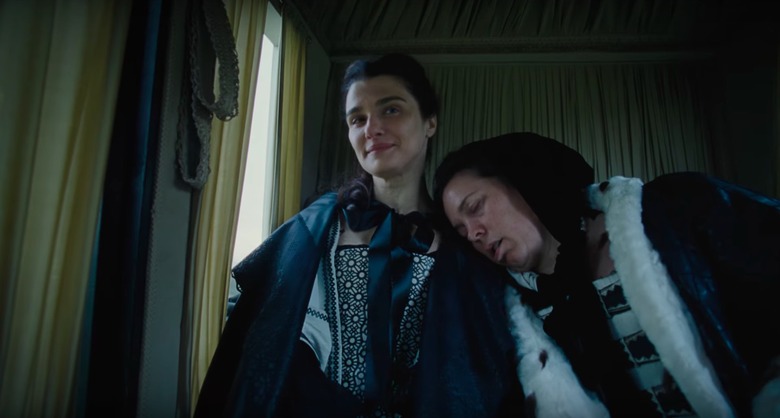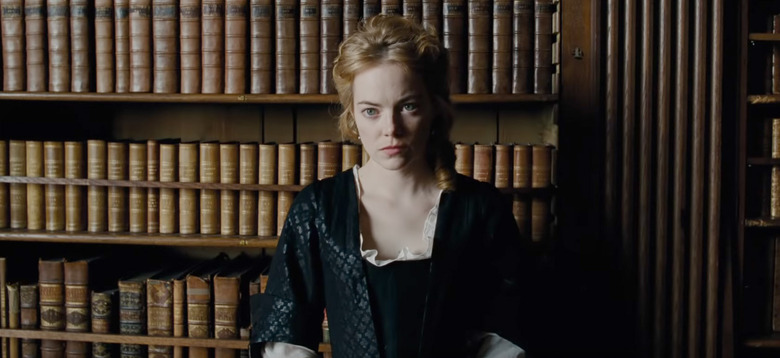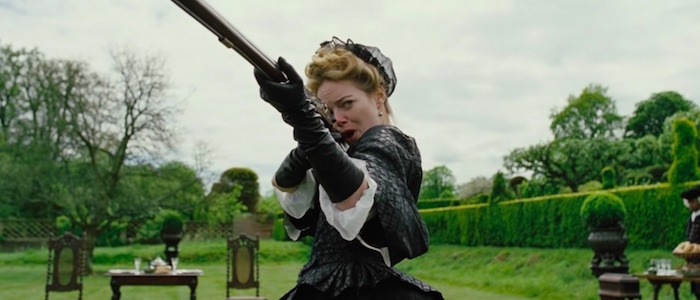Exploring The Strange And Absurd True History Of 'The Favourite'
The Favourite is, predictably, a somewhat fictionalized telling of the story of Queen Anne (Olivia Colman) and the rivalry between two of the most important women in her life: Sarah Churchill (Rachel Weisz) and Abigail Masham (Emma Stone). But you might be surprised to learn that the latest work of darkly comedic idiosyncrasy from Yorgos Lanthimos is actually more faithful to history than most period dramas. When it comes to monarchy, truth is often stranger (and more absurd) than fiction, and the embellished bits of Deborah Davis and Tony McNamara's screenplay only serve to enrich the true story on which The Favourite is based.So exactly how much of The Favourite is fact, and how much is fiction? In this companion piece, we'll explore the life of the real Queen Anne (including her ill health), the party politics at play in her court, her relationships with Sarah Churchill and Abigail Hill, the alleged love triangle between the three women, and the ultimate outcome.
Queen Anne
The Favourite opens on Queen Anne later in life, and depicts her as someone who is not entirely secure in her position as England's ruler. This Anne is insecure in her appearance and the way the court perceives her. Throughout the film, Sarah preys on these vulnerabilities to the benefit of her own political ambitions; in one scene, she remarks that Anne's "dramatic" makeup makes her look like a badger. Although much of this is true, Lanthimos' film portrays Anne as a bit more meek in matters pertaining to politics and the court than she was in real life: According to Susan Kingsley Kent's Gender and Power in Britain, Anne "acted decisively and relied on her own judgment in making policy." That said, she wasn't exactly the most scholarly of rulers. Lanthimos depicts Anne as being childlike in temperament and rather aloof – if not somewhat daft – which isn't far off from the real Anne, whose formal education was largely centered around the Anglican church, per her uncle's wishes.Anne's reign as Queen began in 1702 and ended in 1707, just one year prior to the death of her husband, Prince George of Denmark. Unlike many of her predecessors, Anne sort of fell into the role of Queen by circumstance; her uncle, the previous ruler Charles II, had no legitimate heirs, and after her father was deposed in the Glorious Revolution of 1688, Anne's sister Mary and her husband William of Orange inherited the crown. When Mary died in 1694, William ruled alone until 1702 – though his reign was tenuous at best. Anne and Mary were once very close, but became estranged after the latter ascended to the throne; Mary disapproved of many of her sister's choices, in particular her relationship with Sarah Churchill, who had become Anne's mistress of bedchamber upon her marriage to George.George has been entirely excised from the narrative of the film, likely because he wasn't particularly interesting in the first place. Although arranged, the marriage between Anne and George was mostly pleasant and unremarkable, but throwing her husband into the mix would only complicate The Favourite's focus on the relationships between Anne, Sarah Churchill, and Abigail Hill.When Mary suspected Sarah and her husband, the Duke of Marlborough, of conspiring against the crown, Anne rebelled against her sister by bringing Sarah to a public event at the palace. Anne refused Mary's request to discharge Sarah from her household, leading to an irreparable rift between the sisters.It is true that Anne had lost "some 17 children." As she notes in the film, several were "born as blood" (miscarried), others were stillborn, and the few that survived childbirth did not live for long. In 1684, Anne suffered her first loss when she gave birth to a stillborn child. This was followed over the next couple of years by the birth of two daughters, Mary and Anne Sophia. Over the course of a particularly horrific week in 1687, Anne miscarried and her husband and daughters contracted smallpox. George survived, but their two daughters did not. Then, in April of 1692, Anne gave birth to a son who died a few minutes later. Her sister Mary came to visit – but not for emotional support. In what would become the final meeting between the sisters, Mary spent the visit scolding Anne and criticizing her relationship with Sarah.
Although there is not a single mention of Mary in The Favourite, the solemn echo of that heartbreak is felt in the film's depiction of Anne's female relationships – which are at once both romantic and reminiscent of the intimacy shared between sisters. It's clear that the fictional version of Anne, much like her real-life counterpart, is looking to fill very specific voids in her life, as she does with the 17 rabbits – one for each child she lost. Unfortunately, the real Anne did not keep pet rabbits, which were perceived entirely as food – not pets – at the time.As for Anne's health, it's true that she suffered from an eye condition, as well as an autoimmune disorder of some kind, diagnosed as gout. At the time, gout was perceived to be a disease of nobility, also known as morbus dominorum et dominus morborum, or lord of disease and disease of lords. According to David Green in his biography, Queen Anne, she began suffering from the painful disorder around 1698. The gout spread from her limbs to her stomach and head, and it became increasingly difficult for Anne to get around on her own. As depicted in the film, she often used a wheelchair or was carried in a sedan chair. What the film omits, however, is that she would often drive herself around her estates in a one-horse chaise. Green's biography quotes the essayist and satirist Jonathan Swift, who described Anne driving herself around "furiously like Jehu." Her affliction led to a more sedentary lifestyle, which in turn led to weight gain, of which Sarah cruelly remarked that "she grew exceeding gross and corpulent," according to Green. In the same book, the author quotes Sir John Clerk's description of Anne in 1706:
"...under a fit of the gout and in extreme pain and agony, and on this occasion everything about her was much in the same disorder as about the meanest of her subjects. Her face, which was red and spotted, was rendered something frightful by her negligent dress, and the foot affected was tied up with a poultice and some nasty bandages. I was much affected by this sight."
Spa treatments, such as the mud bath seen in the film, were a common relief for gout in the 1700s. This was much preferable to an earlier European style of treatment detailed by 16th century historian Lorenz Fries: "Roast a fat old goose and stuff with chopped kittens, lard, incense, wax and flour of rye. This must all be eaten, and the dripping applied to the painful joints." (As for the stroke, Anne did not suffer this misfortune of health until 1714.)There is, as you can see, a fair amount of Anne's life prior to the events of The Favourite that has been excised from the narrative – though it's largely the sort of banal familial history that is both irrelevant to the story at hand and also, frankly, tedious as hell. (I highly recommend listening to the audiobook version of Queen Anne: The Politics of Passion by Anne Somerset before bedtime. The pleasant British voice of the female narrator is better than Valium.)
Harley and the Politics of War
The most fictional aspects of The Favourite are, thankfully, those regarding the Tory and Whig parties and the ongoing arguments at court over the war efforts. I'll spare you much of the tedious details, but basically: The two-party system was solidified during Anne's reign. Harley spoke for the Tory party, which was defined by its support of the Anglican church (of which Anne was a devout member) and representation of the common landholders – hence Harley's preoccupation with preventing any further raises in land tax for the war, which he staunchly opposed. The Whigs were defined by their commercial and capitalist interests and were aligned with Protestant Dissenters. Essentially, the Tories were like if Democrats supported the integration of church and state, and the Whigs were like the GOP.If anything, The Favourite makes Harley and this whole political corner of the queen's life far more interesting than it probably was. Harley was not anointed Prime Minister, as depicted in the film. He did however eventually become Lord High Treasurer, and it was through this position that Harley was able to achieve the peace he desperately sought for his country. Where the real Harley and the fictional Harley differ most is in age; the film portrays him as a handsome young man whose sexuality is delightfully vague, but in real life, Harley was in his 40s and probably nowhere near as wonderful or catty. The depiction of Sarah Churchill's husband, the Duke of Marlborough, is similarly accurate, for the most part; he was in charge of the British forces and did lead them to more than one victory.Sarah frequently encouraged the queen to appoint more Whigs to the cabinet and diminish the power of the Tories, with whom Anne was more closely aligned. Anne was displeased with Sarah's meddlesome overtures, which is where the real trouble between the two longtime friends began.
Sarah Churchill, the Duchess of Marlborough
Okay, let's get into the meaty stuff. As previously mentioned, Sarah became Anne's lady of bedchamber following her marriage to Prince George in 1683, though the two first became friends around 1671 when Anne was just six years old. Back then, the future Duchess of Marlborough was known as Sarah Jennings, and, contrary to the film's depiction, she was actually older than Anne by several years. As told by Somerset, Anne was "irresistibly drawn to this self-assured and dynamic woman," and Sarah shrewdly took advantage of her positioning. Or, as aptly described by Edward Potts Cheyney in A Short History of England, "While Anne ruled England, it was Marlborough, and still more Lady Marlborough, who ruled the queen." Cheyney went on to describe the dynamic between the two women, and how Sarah "frequently criticized the queen so harshly so as to reduce her to tears, and dictated to her just what she should do and say under certain circumstances."The Favourite is mostly faithful to the real-life dynamic between the two women; there are several scenes in which Sarah scolds Anne and remarks on her appearance. And while their closeness was well-documented, the romantic nature of their relationship has never been confirmed. As Somerset writes in The Politics of Passion, it was normal for women to have romantic friendships and share an "impassioned, asexual love," but many of Anne's critics felt as though her relationships with women were a little too... intimate. Sarah was indeed in charge of the private royal treasury and bookkeeping, a position that was traditionally held by a man, and as one of Anne's favorites (of which there were more than a couple), she received many gifts from the queen.This included, as seen early in the film, an entire palace. Blenheim Palace was intended as a gift to commemorate the Duke of Marlborough's victory over French and Bavarian forces at the Battle of Blenheim in 1704. The film's depiction of Sarah's political maneuvering is mostly accurate, though the reason for her dismissal from the queen's service is not. Sarah was not poisoned by Abigail – or, if she was, it was never documented. The Duchess actually did a bit of her own gravedigging: Her growing jealousy over the queen's younger favorite and her relentless insistence on Abigail's dismissal eventually led to her downfall.The discord between Anne and Sarah grew exponentially in 1708, when two things occurred: First, Sarah came to court with an inflammatory poem about the Queen's favorites that read, in part, "[Anne's] secretary she was not/ Because she could not write/ But had the conduct and the care/ Of some dark deeds at night" – referring, of course, to Abigail. The exact provenance of the letter appears to be unknown, though Somerset believes it was written by a Whig propagandist, while Kent thinks it was "probably penned by the private secretary to Sarah Churchill." Later that year, at a thanksgiving service, Anne refused to wear the jewelry that Sarah had picked out for the occasion. This was followed by an argument between the two women that ended with Sarah telling the queen to be quiet.While The Favourite doesn't recount the particulars of Sarah's fall from favor and eventual dismissal (in 1711), it does cut to the heart of the matter: Abigail Hill.
Abigail Hill
Abigail is introduced in The Favourite as a newcomer to the palace; her family, once well-regarded, has fallen on hard times and she is now working as a lowly servant. She first encounters Sarah when she makes the well-intentioned mistake of attempting to soothe the queen's gout with a poultice made from herbs she picked on the palace grounds. When Sarah discovers that Abigail is her cousin and that the makeshift gout ointment actually helped the queen, she promotes Abigail to her personal employ.The real-life Abigail was not only related to Sarah, but also to Robert Harley (portrayed in the film by Nicholas Hoult), the Speaker of the House of Commons. She was the cousin of both; Abigail's mother was Sarah's aunt, and Sarah was the second cousin of Harley by relation on her father's side. Abigail and her family had indeed fallen in status due to her father's gambling debts, but the stories of her being lost in a game of Whist and repeated rapes at the hands of a "balloon-shaped German" were fabricated by the screenwriters. As detailed by Somerset and others, Abigail was working as a servant to Sir John Rivers of Kent when Sarah discovered what had become of this part of her family. It was out of a sense of public embarrassment – not kindness – that Sarah decided to employ Abigail as her own servant for a period of time before securing a position for her as a lady of bedchamber to Queen Anne.In 1704, Anne was growing irritated with Sarah, who – when she wasn't lecturing her queen and dear friend about politics – was increasingly absent from court. Anne turned to Abigail in Sarah's absence, and began to rely more and more on her for support and advice. As Edward Gregg writes in Marlborough in Exile, the kind Abigail was everything the blunt and domineering Sarah was not, and she offered Anne the sort of gentle compassion the queen had been craving – but had never received – from Sarah. Again, The Favourite mostly gets this right, though many doubt that Abigail was the manipulative type, despite her secret marriage to Samuel Masham and the ensuing drama – which, again, is largely accurate, though Sarah did not find out about the marriage until months later. When she went to Anne to tell her about the wedding, the queen already knew because she was present for the ceremony. Anne claimed that she had told Abigail to inform Sarah about the marriage. It was during this meeting, in 1707, that Sarah first learned of Abigail and Anne's growing intimacy and that the pair had been enjoying each other's company privately for some time.Abigail did in fact use her position in the queen's favor to her political advantage; she and Harley shared similar political beliefs, and Abigail helped her cousin gain private access to the queen. This enraged Sarah, who had used her own position for personal political gain, and her attempts to have Abigail dismissed included commissioning help from the Whig party – with which she and her husband, the Duke of Marlborough, were affiliated.Following Sarah's dismissal from court, Abigail was named Privy to the Purse, but – unlike The Favourite's version of events – she did not take on all of Sarah's prior duties or titles. As historian Rachel Judith Weil details in Political Passions, Queen Anne bestowed several of those responsibilities (along with that sizable key to her bedchamber) upon another of her favorites, Elizabeth Seymour, the Duchess of Somerset.
Illicit Trysts and Games of Whist
While it may seem a bit too scandalous to be true, Sarah did threaten to leak intimate love letters she had both sent to and received from the queen. As Somerset writes in The Politics of Passion, Sarah is quoted as telling Anne, "Such things are in my power that if known... might lose a crown." Of the letters, Sarah once wrote, "Though your Majesty takes care to make them less pleasing to me, I cannot yet find it in my heart to part with them ... I have drawers full of the same in every place where I have lived."Though the romantic nature of Sarah and Anne's relationship has long inspired robust gossip and speculation, Somerset doesn't buy it. For one, she describes Anne as a woman known for her "prudery, and her strong sense of Christian morality." While Sarah was gleefully spreading rumors about the romantic relationship between Anne and Abigail, she was simultaneously debunking similar gossip about the nature of her own relationship with Anne. Sarah, Somerset writes, believed "lesbianism was a disgusting vice," and "Far from allowing that Anne had ever physically desired her, she represented Anne's affection for herself as being inspired purely by her intellect and forthright character."In Political Passions, Weil details how Sarah further fed the gossip mill with regards to Anne and Abigail's relationship. Anne was, as Sarah wrote in one letter, "exposed to be the talk of all courts and countries, for so wrong a thing, as having such a fondness for a bedchamber woman, and being so much governed by her." Sarah was always careful never to blatantly accuse Anne and Abigail of being involved in a lesbian relationship, though she implied as much both in public and in private.
The Dismissal
Sarah's dismissal is depicted as somewhat unremarkable in the film, save for the highly-fictionalized poisoning and subsequent (but brief) brothel stay. After retiring to her estate with the Duke of Marlborough, Sarah is encouraged by the Earl of Godolphin to write a letter of apology to the queen in an effort to mend their broken relationship. Abigail intercepts the letter and tosses it in the fireplace, lest her position – and reclaimed status as a lady – be threatened. As a bit of insurance, Abigail tells the queen how Sarah and her husband skimmed from the royal purse, leading to their official banishment.In reality, it wasn't just Sarah's gossip-spreading and outspoken resentment of Abigail that led to her dismissal, but also the way she behaved following the death of Anne's husband, George. During the grieving period, Sarah refused to wear the appropriate clothes for mourning, which made many feel as though she did not respect Anne's grief – nor did she believe it to be genuine. According to Green in his biography, Sarah also had a portrait of George removed from Anne's bedchamber and refused to return it because she believed it only proper for those in mourning "to avoid seeing of papers or anything that belonged to one that one loved when they were just dead."As detailed by Ophelia Field in The Favourite: Sarah, Duchess of Marlborough, Sarah met with Anne one last time in 1710, at which time she asked her royal friend to explain why she had fallen out of favor. According to Sarah's own recollection of the meeting, Anne was "unmoved" and would only respond in cold, short sentences like, "I shall make no answer to anything you say" and "you may put it in writing." Sarah's husband, the Duke of Marlborough, pleaded with the queen to let them remain in their positions a while longer, but Anne refused. The Duchess of Marlborough's titles and responsibilities were, as aforementioned, divided among Abigail (now Lady Masham) and the Duchess of Somerset, which only upset Sarah even more because Anne had promised to give them to her children.Sarah and her husband traveled through Europe and, due to the Duke of Marlborough's victorious war efforts, were treated favorably. Anne and Sarah never reconciled, but according to at least one rumor detailed by Gregg in Marlborough in Exile, the queen was once overheard asking if the Marlboroughs had "reached the shore," which some took to mean that she had invited her old friend back to England. That bit of hearsay was never confirmed, but what is known is that Sarah and her husband returned to England on the day of Anne's death. Anne died on August 1, 1714, two days after suffering a stroke. Although Sarah never returned to the queen's favor, she and her husband's livelihoods were fully restored under Anne's successor, King George I.

